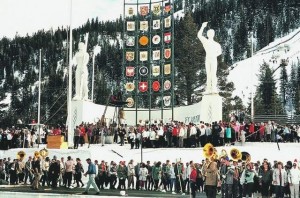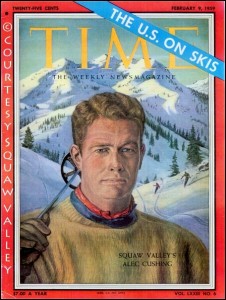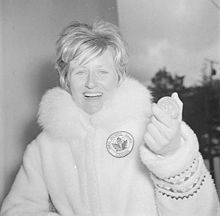 Last week I shared some of my memories of the 1960 Squaw Valley Olympics. This week I’ll cover some of the aspects of those Olympics that made them significant beyond just my memories.
Last week I shared some of my memories of the 1960 Squaw Valley Olympics. This week I’ll cover some of the aspects of those Olympics that made them significant beyond just my memories.
Squaw Valley was a long shot at hosting the winter Olympics from the beginning. The U.S. Olympic committee wasn’t convinced that Squaw Valley was a viable choice. There was nothing there in the way of facilities. Even the ski area wasn’t up to international standards. Alexander Cushing, one of Squaw Valley’s owners, had to convince the committee to take the proposal seriously. His efforts succeeded and in 1955 the U.S. Olympic Committee submitted Squaw Valley as its candidate to host the 1960 Olympics. IOC President Avery Brundage was quoted as saying that the U.S. Committee had “lost leave of their senses!”
 Cushing went back to work again and eventually his efforts led to the IOC choosing Squaw Valley over the favored Innsbruck. One of Cushing’s strategies was to use influential Europeans to lobby for Squaw Valley. One of those was Stowe’s Sepp Ruschp who still carried a lot of influence in Europe. Once Squaw Valley was selected, Ruschp joined the U.S. organizing committee for the Olympics.
Cushing went back to work again and eventually his efforts led to the IOC choosing Squaw Valley over the favored Innsbruck. One of Cushing’s strategies was to use influential Europeans to lobby for Squaw Valley. One of those was Stowe’s Sepp Ruschp who still carried a lot of influence in Europe. Once Squaw Valley was selected, Ruschp joined the U.S. organizing committee for the Olympics.
Another Cushing strategy was that Squaw Valley was a blank canvas on which the perfect Olympics could be painted. He proposed an Olympic Village dedicated to the athletes where they would live, interact, and compete. Up until then the winter Olympics were held in established resort towns where the athletes usually stayed in hotels. Squaw Valley set the model for the village concept that has been followed ever since.
Other Squaw Valley firsts included electronic timing that could record results to the hundredth of a second, artificial ice, and computerized result tabulation. Squaw Valley can also claim to be where instant replay began. When questions arose over whether a competitor in the men’s slalom had missed a gate or not, officials went to CBS to review the tapes of the event. CBS saw the value of this function and instant replay was born.
In the alpine skiing events results were spread around among individuals and countries. As mentioned last week only Penny Pitou won multiple medals. In the men’s events Jean Vuarnet of France won the downhill – yeah, that’s the same as the sunglasses. Vuarnet was the first Olympic winner to use metal skis. The GS winner was Roger Staub of Switzerland and the slalom winner was Ernst Hinterseer of Austria. Hinterseer would eventually join Emo Heinrich at Stratton Mountain as one of the Stratton Mountain Boys.
In the women’s events Heidi Biebl of Germany won the downhill event and Yvonne Rüegg of Switzerland won the GS. Who was the slalom winner that beat Betsy Snite for the gold?
Barry Stone knew that it was Anne Heggtveit of Canada. Barry was instrumental in organizing those U.S. Olympic Ski Challenge fund raisers that were held in Stowe in the 1990s. He recalls having Anne and her husband Ross Hamilton as special guests at one of those events.
 Heggtveit was from Ottawa and began skiing at age 2. She made an impact on the international scene at age 15 when she won the Holmenkollen GS, the youngest ever to accomplish that. Her gold at Squaw Valley made her the first Canadian to win an alpine skiing gold medal. After getting married to Ross Hamilton, the couple moved to the eastern townships and Anne became a ski instructor at Jay Peak. In 1979 they moved to Vermont and now live in North Hero.
Heggtveit was from Ottawa and began skiing at age 2. She made an impact on the international scene at age 15 when she won the Holmenkollen GS, the youngest ever to accomplish that. Her gold at Squaw Valley made her the first Canadian to win an alpine skiing gold medal. After getting married to Ross Hamilton, the couple moved to the eastern townships and Anne became a ski instructor at Jay Peak. In 1979 they moved to Vermont and now live in North Hero.
Peter Lawlor also correctly named Anne Heggtveit as the slalom winner. It’s an interesting coincidence that Peter and Barry were the two with the correct answer. Awhile back Barry suggested to me that it would be interesting to see who can claim the record for the most consecutive years with a Stowe season pass. He believes he’s a contender for that record. Another possible record would be who has been skiing Stowe for the longest time and is still skiing here. Peter is a contender for this record since he started skiing at Stowe in 1943!

Leave a Reply